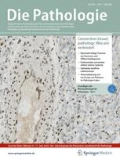Zusammenfassung
Nichtserratierte Vorläuferläsionen von Tumoren des Dickdarms umfassen die klassischen (tubulären, tubulovillösen und villösen) Adenome und die Dysplasie (intraepitheliale Neoplasie) bei chronisch-entzündlichen Darmerkrankungen und bei den seltenen hamartomatösen Polyposesyndromen. Diese kurze Übersicht fasst die aktuelle Literatur zum Thema Adenom-Karzinom-Sequenz zusammen. Besondere Berücksichtigung erfahren dabei die Themenkomplexe Kolonstammzellen und funktionelle Organisation der Krypte sowie klonale Konversion in der Formation des monokryptalen Adenoms. Die Bedeutung einer klonalen Interaktion zwischen benachbarten Krypten sowie die Genese (großer) monoklonaler Adenome aus (kleinen) polyklonalen Vorläuferläsionen wird diskutiert. Am Ende der Übersicht wird auf die molekulare Tumorentstehung und deren klinische Bedeutung bei den chronisch-entzündlichen Darmerkrankungen und bei den hamartomatösen Polyposesyndromen eingegangen.
Abstract
Non-serrated precursor lesions of colorectal tumours include conventional adenomas (tubular, tubulovillous and villous), inflammatory bowel disease-associated dysplasia (intraepithelial neoplasia), and hamartoma-associated dysplasia. This short review summarizes the current literature on the adenoma-carcinoma sequence, focusing on colonic stem cells and functional crypt organization, patterns of stem cell division, niche succession and clonal conversion in the formation of a monocryptal adenoma. The process of clonal interaction between neighboring crypts as well as the development of large monoclonal adenomas from small polyclonal precursor lesions is discussed in detail. Finally, the molecular pathogenesis as well as the clinical significance of inflammatory bowel disease- and hamartoma-associated carcinogenesis is addressed.






Literatur
Baretton GB, Aust DE (2008) Intraepitheliale Neoplasie / Dysplasie – Diagnose bei Colitis ulcerosa. Pathologe 29:280–285
Brabletz S, Schmalhofer O, Brabletz T (2009) Gastrointestinal stem cells in development and cancer. J Pathol 217:307–317
Calva D, Howe JR (2008) Hamartomatous polyposis syndromes. Surg Clin North Am 88:779–817
Chen HM, Fang JY (2009) Genetics of the hamartomatous polyposis syndromes: a molecular review. Int J Colorectal Dis 24:865–874
Fearon ER, Vogelstein B (1990) A genetic model for colorectal tumorigenesis. Cell 61:759–767
Fearon ER (2011) Molecular genetics of colorectal cancer. Annu Rev Pathol 6:479–507
Esteller M, Sparks A, Toyota M et al (2000) Analysis of adenomatous polyposis coli promoter hypermethylation in human cancer. Cancer Res 60:4366–4371
Hiraoka S, Kato J, Tatsukawa M et al (2006) Laterally spreading type of colorectal adenoma exhibits a unique methylation phenotype and K-ras mutations. Gastroenterology 131:379–389
Humphries A, Wright NA (2008) Colonic crypt organization and tumorigenesis. Nat Rev Cancer 8:415–424
Hurlstone DP, Cross SS, Drew K et al (2004) An evaluation of colorectal endoscopic mucosal resection using high-magnification chromoscopic colonoscopy: a prospective study of 1000 colonoscopies. Endoscopy 36:491–498
Kaku E, Oda Y, Murakami Y et al (2011) Proportion of flat- and depressed-type and laterally spreading tumor among advanced colorectal neoplasia. Clin Gastroenterol Hepatol 9:503–508
Kim BC, Chang HJ, Han KS et al (2011) Clinicopathological differences of laterally spreading tumors of the colorectum according to gross appearance. Endoscopy 43:100–107
Kudo S, Lambert R, Allen JI et al (2008) Nonpolypoid neoplastic lesions of the colorectal mucosa. Gastrointest Endosc 68:S3–S47
Lash RH, Genta RM, Schuler CM (2010) Sessile serrated adenomas: prevalence of dysplasia and carcinoma in 2139 patients. J Clin Pathol 63:681–686
Merritt AJ, Gould KA, Dove WF (1997) Polyclonal structure of intestinal adenomas in ApcMin / + mice with concomitant loss of Apc + from all tumor lineages. Proc Natl Acad Sci U S A 94:13927–13931
Morin PJ, Sparks AB, Korinek V et al (1997) Activation of beta-catenin-Tcf signaling in colon cancer by mutations in beta-catenin or APC. Science 275:1787–1790
Novelli MR, Williamson JA, Tomlinson IP et al (1996) Polyclonal origin of colonic adenomas in an XO / XY patient with FAP. Science 272:1187–1190
Odze RD, Riddell RH, Bosman FT et al (2010) Premalignant lesions of the digestive system. In: Bosman FT, Carneiro F, Hruban RH, Theise ND (eds) WHO classification of tumours of the digestive system. IARC, Lyon, pp 10–12
Parra-Blanco A, Gimeno-García AZ, Nicolás-Pérez D et al (2006) Risk for high-grade dysplasia or invasive carcinoma in colorectal flat adenomas in a Spanish population. Gastroenterol Hepatol 29:602–609
Pino MS, Chung DC (2010) The chromosomal instability pathway in colon cancer. Gastroenterology 138:2059–2072
Radtke F, Clevers H (2005) Self-renewal and cancer of the gut: two sides of a coin. Science 307:1904–1909
Reya T, Clevers H (2005) Wnt signalling in stem cells and cancer. Nature 434:843–850
Ricci-Vitiani L, Pagliuca A, Palio E et al (2008) Colon cancer stem cells. Gut 57:538–548
Ricci-Vitiani L, Fabrizi E, Palio E, De Maria R (2009) Colon cancer stem cells. J Mol Med 87:1097–1104
Rüschoff J, Heinmöller E, Hartmann A et al (2010) Differenzialdiagnostik erblicher Dickdarmkarzinomsyndrome. Der Beitrag der Pathologie. Pathologe 31:412–422
Sanchez JA, Dejulius KL, Bronner M et al (2011) Relative role of methylator and tumor suppressor pathways in ulcerative colitis-associated colon cancer. Inflamm Bowel Dis. doi:10.1002 / ibd.21526. [Epub ahead of print]
Spring KJ, Zhao ZZ, Karamatic R et al (2006) High prevalence of sessile serrated adenomas with BRAF mutations: a prospective study of patients undergoing colonoscopy. Gastroenterology 131:1400–1407
Takahashi T, Nosho K, Yamamoto H et al (2007) Flat-type colorectal advanced adenomas (laterally spreading tumors) have different genetic and epigenetic alterations from protruded-type advanced adenomas. Mod Pathol 20:139–147
Vaahtomeri K, Mäkelä TP (2011) Molecular mechanisms of tumor suppression by LKB1. FEBS Lett 585:944–951
Zeki SS, Graham TA, Wright NA (2011) Stem cells and their implications for colorectal cancer. Nat Rev Gastroenterol Hepatol 8:90–100
Danksagung
Der Autor dankt Herrn Prof. Dr. Helmut Neumann, Erlangen, für die Überlassung von Abb. 2.
Interessenkonflikt
Der korrespondierende Autor gibt an, dass kein Interessenkonflikt besteht.
Author information
Authors and Affiliations
Corresponding author
Rights and permissions
About this article
Cite this article
Langner, C. Nichtserratierte Vorläuferläsionen von Tumoren des Dickdarms. Pathologe 32 (Suppl 2), 206 (2011). https://doi.org/10.1007/s00292-011-1495-2
Published:
DOI: https://doi.org/10.1007/s00292-011-1495-2
Schlüsselworte
- Aberranter Kryptenfokus
- Adenom
- Hamartomatöse Polypose
- Chronisch-entzündliche Darmerkrankung
- Monoklonale Konversion

